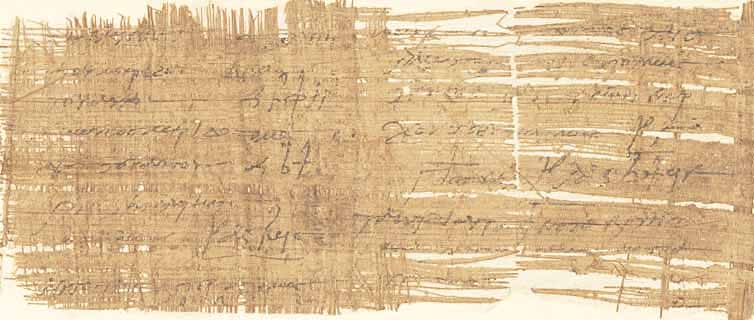BGU III 1568 (P. 8959)
Before making a purchase, people like to check what they are buying. This is how people already thought 2000 years ago, as this Greek contract for two donkeys shows. Interestingly, this fact only becomes apparent at second glance.
The papyrus came to the Berlin Papyrus Collection in 1894 and probably came from the private collection of the Berlin newspaper publisher and businessman Rudolf Mosse. The object was originally found in Fayum, an oasis south-west of Cairo. We learn more about its origin from the text. In the third line of the text, the place Soknopaiou Nesos, today’s Dime, is mentioned, even though the papyrus is badly damaged at this point and the place name is therefore only very incompletely preserved. The origin of the text can therefore be regarded as certain. This ancient village was located on the north side of Lake Moeris in the Fayum and was famous for its large temple to the crocodile god Soknopaios. In addition, the text begins with a date which, when converted to our modern date system, is 7 February of the year 33 AD.
The Greek text on this papyrus is a rental contract for a white donkey and her white foal. The animals belong to a Stotoetis, son of Horos, who rents them to a Phasis, son of Satabous. The rental period is stated. The lease is to last until 28 August, i.e. just over six months. It is also agreed that Phasis has to pay 3 drachmas a month for both animals. He is also to pay all the costs for the upkeep of the donkeys and the taxes incurred. In return, the tenant is free to decide what he uses the animals for.
Both the contractual partners and the object of the contract (the animals) are described. The age and physical characteristics of the people are given, as is usual in such texts. For example, we learn about Stotoetis that he is about 30 years old and has a scar on his right hand. All we learn about Phasis is that he is about 25 years old. In addition to their white coat colour, the animals are said to be healthy, well-fed and undamaged. In addition, a value of 120 drachmas is given for the donkey and 48 drachmas for the foal.
These details about the animals are taken up again in the explanations about the return conditions. The tenant Phasis is obliged to return both animals healthy, well-fed and undamaged at the end of the rental period or to pay the value of both animals in cash. Stotoetis thus had the certainty that he would receive his two animals or their value in money.
At the end of the contract, a Charimedon personally confirms that the contract is valid. Both parties to the contract also sign the document in their own hand, summarising the content of the contract and the respective obligations once again. It is interesting to note that Stotoetis did not write in Greek, but in Demotic. Apparently he did not speak Greek or was at least bilingual and favoured Demotic. Phasis, on the other hand, signed in Greek.
A small detail in the return conditions of this rental agreement is interesting. While at first glance it appears as if the main aim was to ensure that Stotoetis receives his animals or a replacement, these conditions should also be understood to mean that the tenant Phasis is free to choose between returning the animals correctly and paying for them at the end of the rental period. He could therefore use both animals for several months and consider whether he wanted to purchase them at the end. The rental period therefore appears to be a trial period.
Stotoetis is also known from other texts. In a text four years older, for example, he acquires a male donkey foal. In this text, too, he was already described as a man aged around 30 with a scar on his right hand.



